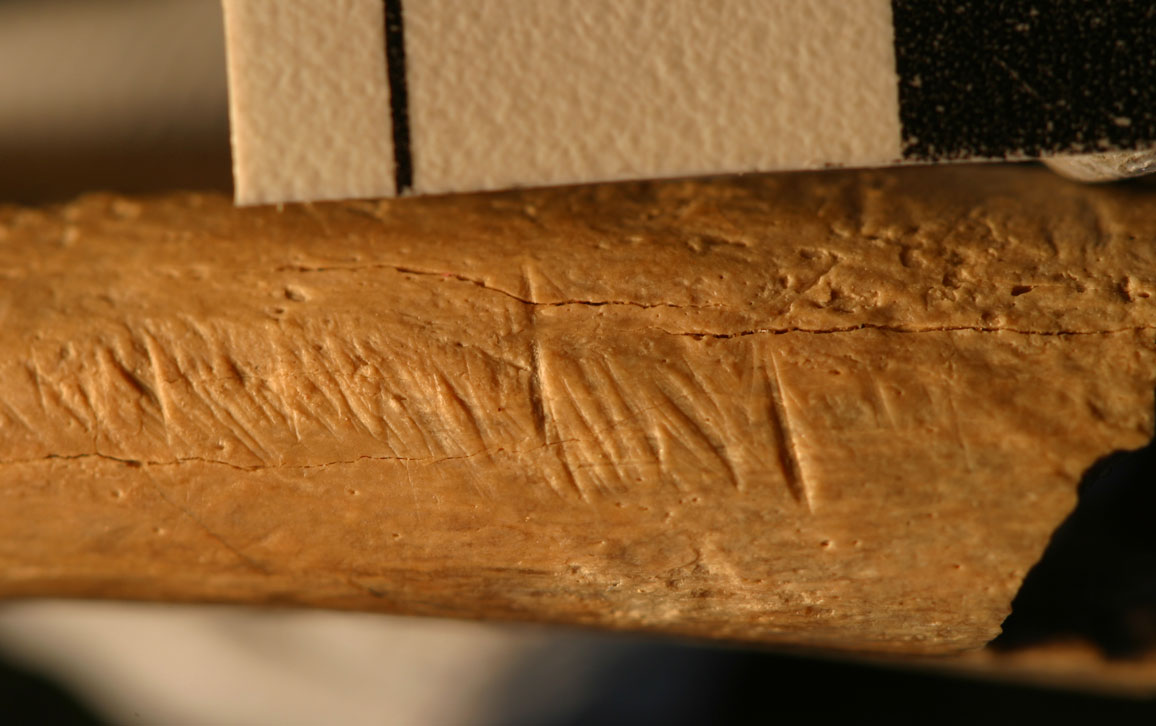Reviewing the Prehistoric Menu
By Sandra J. Ackerman
First Person: Briana Pobiner
First Person: Briana Pobiner

As a research scientist at the Smithsonian Institution’s Human Origins Program, Briana Pobiner has long been fascinated by the role of diet in human evolution. In a 2016 article for American Scientist, Pobiner discussed scientific studies that were then beginning to reveal what our human ancestors ate, how they procured food, and what processes they may have followed to make that food palatable and digestible. Further research in archaeology, paleoecology, and other fields, including the analysis of ancient dental plaque, has already done much to contradict the image of our human ancestors as club-wielding carnivores and instead is showing that the genus Homo has thrived by being able to eat a wide variety of foods. Pobiner spoke with contributing editor Sandra J. Ackerman about recent developments in the study of human diet. (This interview has been edited for length and clarity.)
Diets that claim to be based on the eating habits of our Paleolithic ancestors have become popular with many health influencers. How much scientific evidence do we actually have about what early humans were eating?
In the modern conception of a paleo diet, a lot of the emphasis is not on which foods to eat but rather on which ones to avoid—for instance, grains or dairy or legumes—based on the assumption that our ancestors didn’t eat these foods, they just ate a lot of meat. The problem is, we don’t have good evidence for a whole lot of meat eating, certainly not on the scale suggested by adherents of a paleo diet.

Smithsonian Institution
There is good evidence in the fossil record that Neanderthals—our close evolutionary relatives, now extinct— were capable hunters, that they butchered and ate a lot of large animals. But they also ate plants, and they also cooked their food. The idea that any early human species had a very narrow diet is likely not accurate. It was probably our omnivory—the ability to eat a large variety of things—that helped us to survive and to reproduce.
What about the modern human diet?
In terms of our digestive system, humans today are still omnivorous. But when it comes to our evolutionary history, I think one reason we talk a lot about meat eating is that it’s so much easier to find evidence of it in the form of fossil animal bones, including those with tool marks that we know for sure are the result of butchering by early humans. It’s much harder to find evidence for early humans eating plants or other foods.
Why is that evidence harder to find?
It’s really an inherent bias—not a deliberate bias, but the filtering of what gets preserved in the prehistoric record. It’s easier to find fossilized animal bones with clear indications of butchering than to find well-preserved plants clearly eaten by early humans, or to examine early human fossils and see if they have any bits of preserved plants stuck in the tartar or calculus on their teeth.
Does plant eating leave characteristic marks on teeth?
Well, sort of. You can tell something about the properties of plants that an animal ate by the pits and scratches on its teeth. The same goes for early human teeth. But when you have phytoliths [microscopic particles of silica that form within plants] embedded in the calculus of teeth, that’s really a smoking gun that the plant ended up there because someone ate it.
There’s also a lot of work now on the analysis of ancient proteins as a window into early human diet. How is that research carried out?
In studies of stone tools that were used to butcher animals, ancient proteins have been extracted from the edges of those tools. For example, at an archaeological site in Jordan that’s about 250,000 years old, a research team led by University of Victoria archaeologist April Nowell found blood protein residues from only one kind of animal on each tool. So they know, or at least they can infer pretty strongly, that this tool was used to butcher a horse, that tool was used to butcher a duck, and that other tool was used to butcher a rhino. That’s pretty cool.
So the menu for our ancestors of, say, 300,000 years ago could have included a variety of both meats and plants?
Sure! And another important part of early diet we don’t often think about would have been fat. One explanation for all these butchery-marked bones is that it may have been not just the meat itself but the bone marrow that early humans were going after, because marrow is so high in fat and calories, which are difficult to find in African savannah ecosystems. That’s a testable hypothesis, because you would expect to find a lot of percussion marks from the breaking open of bones to get at the marrow. But when you break open a bone, you get a lot of small shards and pieces that may not always have been collected—especially in the past, because they weren’t particularly identifiable in terms of skeletal element or species. So those percussion marks may be on fossils that are missing from our museum collections.
Did human ancestors first start eating meat as scavengers and then at some point go into business for themselves, so to speak? Or did scavenging and hunting take place in tandem?
If the earliest hominins were hunting, I don’t know what they were using to hunt with; we don’t see spear points in the archaeological record until about half a million years ago. That, I think, is a strong point in support of scavenging first. Another point is that as soon as butchery marks turn up in the fossil record, they are appearing on really large animals. The likelihood that a three-and-a-half-foot-tall hominin with no hunting technology was somehow taking down large animals such as elephants doesn’t seem very plausible to me.
Particularly early on, I think scavenging was an important part of how human ancestors got meat and marrow. It’s not until much later that you start to see archaeological sites with butchery-marked animal bones from just one or a few species or from just the big adult males, so we really know that Neanderthals or other early humans are going out and specifically hunting this species. They’re being more picky about what they’re getting. That’s a big shift that happened much later in time, probably by around 500,000 years ago.
One more question about scavenging: In a sunny, exposed area, how long would a carcass be safe to eat?
I suspect it depends on whether a carcass is partially in water, whether it’s in the sunshine or the shade, whether it’s cold or hot, whether it rains a lot, or whatever. My gut instinct, so to speak, is that it’s not going to last more than a couple of days before it starts to smell terrible, there are maggots, and you don’t necessarily want to eat it. But University of Michigan archaeologist John Speth has a hypothesis that some early humans, particularly Neanderthals, were eating putrefied meat. There are ways to preserve meat that involve this type of putrefaction, and some modern human groups do this routinely today, or did in the recent past. Were early humans following predators around? Did they have a good sense of how quickly they had to get in there before the meat spoiled? I don’t know that we’ll ever be able to answer those questions. But I do think the question of how long a potential scavenging opportunity is still viable is a good question that, to my knowledge, no one has looked at yet.
How would you go about investigating that question?
You could do it in a fairly experimental way, either with natural scavenging opportunities or by deliberately leaving parts of animals out in different places and monitoring factors such as pathogen load. I’m sure there are aspects you could measure that would tell you whether it was safe to eat or not. Humans have a surprisingly acidic gut, and some people have speculated that we have scavenging in our ancestry because we’ve had to eat all this food that might have been going off. High levels of acid in our gut could have evolved to deal with food pathogens.
A lot of foods can also be made safe by cooking. How old is the earliest evidence of using fire to cook food?
I would say that the control of fire dates back about a million years, from the site of Wonderwerk Cave in South Africa, which has the earliest evidence for hearths. There are burned bones and plant ashes deep inside the cave. There’s no way that evidence is from a natural wildfire, and the remains were very well preserved and not transported by wind or water. And last year, there was a paper published from the site of Gesher Benot Ya‘aqov, in Israel, that describes evidence for cooking fish about 780,000 years ago, which I think is the earliest solid evidence for cooking—at least for now.

Briana Pobiner
What evidence is there for the earliest cooking of grains?
At a site called Ohalo II, also in Israel, researchers have found good evidence of sort of “paleo-pitas” being made about 23,000 years ago, with the grinding of grains and cooking them in what was almost like an oven. But some of the phytoliths found on Neanderthal tooth calculus are from plant foods that had been cooked 60,000 years ago. These were precursors of grains including barley, rye, and wheat—not domesticated plants, but related to them.
A lot of new information about early human diet has come to light since you first wrote about meat eating and human evolution for American Scientist seven years ago. What’s the main point that you’d like readers to take away from the recent research?
The update is that although there is definitely still strong evidence for some meat eating in human prehistory, we have growing evidence now for the eating of plants and fish and even insects. The record shows that omnivory and flexibility characterized early human diets better than a single most important or dominant food source.
How do you answer the question of what early humans were eating that made our brains suddenly get bigger?
I don’t know that there will ever be a definitive answer. It very well could be a variety of foods, but it also could be that the specific foods themselves weren’t the most significant factor in the evolution of large brains. Maybe it’s the grandmothering hypothesis, which holds that provisioning of food by grandmothers allowed grandkids to eat more consistently, and so made it possible for mothers to give birth to babies more often. These grandmothers then passed their “longevity” genes on to their kids and grandkids, and longevity is correlated with large brains in most mammals.
Recently, I held a session of “Skype a Scientist” with a Canadian scout troop of five- and six-year-old girls. One girl asked, “Was vegetarianism invented back then?” And I thought, people in the past ate whatever they could get their hands on. Diets based on a specific rationale or principle are probably a very modern development.
Click "American Scientist" to access home page
American Scientist Comments and Discussion
To discuss our articles or comment on them, please share them and tag American Scientist on social media platforms. Here are links to our profiles on Twitter, Facebook, and LinkedIn.
If we re-share your post, we will moderate comments/discussion following our comments policy.